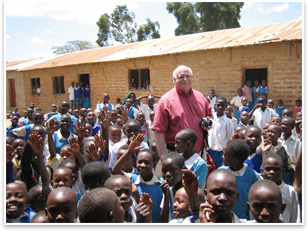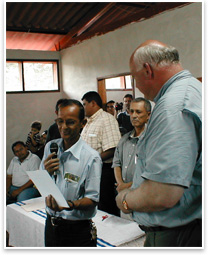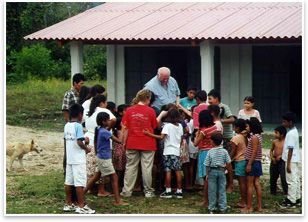 Doer’s
Profile Doer’s
Profile
Charles
Newman, AIA
by Heather Livingston
Contributing Editor
Summary: Charles
Newman, AIA, is the principal at Newman Architects in Naperville,
Ill. and cofounder of the nonprofit Schools for Children of the World
(SCW). His firm was named 2008 Naperville Area Chamber of Commerce
Small Business of the Year and Small Business of the Year in the
6–30 employees category. On March 2, the U.S. Chamber of Commerce
honored Newman Architecture with a Blue Ribbon Small Business Award.
Here, Newman discusses his work building schools in developing countries.
Education
I graduated from the University of Illinois at Champaign-Urbana with
a professional bachelor’s of architecture degree.
Why did you become an architect?
I was always interested in buildings, and when I was a little kid
I used to draw floor plans of homes. I think the thing that really
got me going was when I was in high school I used to work for a
bricklayer in the summer. As a result, I got familiar with buildings
and he taught me how to lay bricks and do the labor.
Hobbies?
I love scuba diving, which I didn’t start until I was 50 years
old. We were doing some schools in Honduras, and I had a chance to
go to Roatan, which is just off the coast, and get certified as a
diver. The other hobby is biking. I also like to play tennis.
 What are you currently reading? What are you currently reading?
One book is called Spark, by Dr.
John Ratey at Harvard. They’ve
been studying the impact of physical fitness on student performance
and learning, working with Phil Lawler, director of outreach & training
for PE for Life, a nonprofit organization dedicated to inspiring
active, healthy living by advancing the development of quality, daily
physical education programs for all children. Most people don’t
think about PE programs and physical fitness as impacting student
learning, but the studies have been able to show
that PE has a big impact on student performance.
Another book that’s really interesting is called Disrupting
Class by Clayton Christensen. It’s written by a non-educator
who is evaluating what he believes could be done to improve student
performance in class. Disrupting Class focuses on engagement as the
secret to student performance. We do all these things to try to improve
kids’ school, and the real secret is how to get them engaged
in learning so that they’re excited about it and want to learn.
When and why did you co-found Schools for Children of the World?
We didn’t intend to co-found a not-for-profit organization.
Bill DeJong is a friend from Columbus, Ohio. He and his son went
to Honduras with their church to help the Christian mission put in
a hydroelectric plant. When he was there, he saw how bad the schools
were so he invited some people to join him on a trip to study the
schools in rural Honduras. I was one of those people who went on
that trip in March 1997. We spent a week studying the schools. Back
in our office, we designed a model school based on the ideas that
we came up with. We went back a year later and met with the community,
and they were pretty excited about it. At that time, we didn’t
have any structure in place. We wrote up an agreement to provide
money for the materials, and the people in the community would donate
labor. The government agreed to provide free of charge lumber that
they confiscated from poachers. We started in February 1998, and
the school was completed that same summer.
How many schools have you completed?
I think we’ve completed six new schools in Honduras. We’ve
renovated over 60 schools in the country, all working to develop
partnerships with the local communities and the national government
to establish policies for the improvement of schools.
Does SCW do design work apart from schools?
We’re always willing to help out wherever we can. We’ve
built homes for single moms. We’ve built churches. We’ve
built clinics. Wherever there’s a need, we try to help out
if we can.
 In
rural communities, you find out that there are very few medical services.
A Christian mission decided to develop a clinic, so we’ve
designed a surgery center for them. We’re also working right
now on developing a special needs clinic. When you get into
rural developing areas where all of the people are subsistence farmers,
if they have a child with a special need they may put them in a back
room, and in some cases may give their children away. In
rural communities, you find out that there are very few medical services.
A Christian mission decided to develop a clinic, so we’ve
designed a surgery center for them. We’re also working right
now on developing a special needs clinic. When you get into
rural developing areas where all of the people are subsistence farmers,
if they have a child with a special need they may put them in a back
room, and in some cases may give their children away.
The special needs clinic will address health needs that are very
treatable. But if you live in rural Honduras, they can go undiagnosed.
The parents will be able to bring their children to this free clinic
and people will be available to diagnose problems and, to the extent
that they can, provide treatment.
For example, one person who comes with us works for the School for
the Blind in Ohio. She’s an audiologist and has found Honduran
kids who have had stones or dead bugs in their ears and their
parents thought the kids were deaf. Because the kids couldn’t
hear, they wouldn’t be allowed to go to school.
Why does SCW focus on schools outside the U.S.?
In the United States, no matter where you are, there are government
organizations that can provide help. There is somebody who’s
responsible for providing the services, and if you look for help,
almost everybody in the United States can find it. If you go to
developing countries, that’s not so. The national and local
governments don’t have the resources to provide all the services
that are needed. The real difference in my opinion is that in developing
countries, there’s very little hope for the people other
than organizations like ours that are willing to help. There is
no place to turn.
What projects are you working on currently?
We’ve got 14 projects going in seven different countries. We’ve
got a brand new school that we’re working on in Honduras. We’re
putting additions on three other schools. We’re working with
the municipio Santa Cruz in Honduras to make it a model for the rest
of the country that incorporates school planning and design, working
with the existing schools, and renovating and building new schools
in a comprehensive way.
In Belize, we’ve designed a secondary school that is a being
constructed by a faith-based mission. We’re working with the
Kenyan government to build a primary school. We’ve designed
Step by Step, a school for children with special needs that’s
tied with a new K–12 school, Grace Academy, in Tanzania.
We’re working with the Rotary Club here in Naperville to build
a primary school in Zambia, and we’re working with a group
in Uganda to build a primary school. I’m currently working
with the Archdiocese of Chicago, which is partnering with the diocese
in Suka, Nigeria, to improve their schools. We’re working together
to provide programs to improve their schools, and there’s a
plan to build a model school for their diocese that they can use
as a model to replicate as they build more schools there.
What advice would you give for doing meaningful pro bono work?
I think architecture in general is all about serving people. I don’t
care whether it’s in your regular practice or pro bono work.
In my opinion, architecture is about maximizing facilities to allow
your clients to achieve their goals. If you can focus on wanting
to help others and looking at things from their perspective, I think
that’s where the greatest value is. That’s really where
your focus needs to be. |



